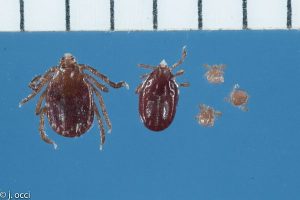
SHARE THIS ARTICLE:
Lyme Bacteria DNA Found in PA Haemaphysalis longicornis Tick
The study “Borrelia burgdorferi Sensu Stricto DNA in Field-Collected Haemaphysalis longicornis Ticks, Pennsylvania, United States” was recently published in the Centers for Disease Control & Prevention (CDC) Emerging Infectious Diseases. Pennsylvania has the highest number of reported Lyme disease cases in the US.

Researchers performed weekly surveillance activities throughout 38 Pennsylvania counties from May 1–September 6, 2019, capturing nymphal I. scapularis ticks (deer tick) and adult and nymphal H. longicornis ticks (Asian longhorned ticks). Sampled sites were mostly high-use public areas located in deciduous forests, considered to be high-risk for recreational and occupational tick exposure, and are H. longicornis and I. scapularis tick habitats.
Using real-time PCR testing, the researchers analyzed a total of 263 questing Asian longhorned ticks from southeastern counties of Pennsylvania. One adult female tested positive for Borrelia burgdorferi sensu stricto, yielding a 0.4% infection rate. I. scapularis ticks collected during the same period and sites had infection rates for B. burgdorferi sensu lato ranging from 16.7% to 57.1%.
Previous Pennsylvania studies focused primarily on collecting and testing deer ticks – the primary vector of the Lyme disease-causing bacteria – and identified nearly 50% as carrying Borrelia burgdorferi sensu stricto. These initial surveillance efforts also recovered H. longicornis ticks.
H. longicornis was first discovered in New Jersey in 2017 and ever since the number of states that have reported confirmation of its presence has rapidly increased. The study’s authors note that, “Because ecologic characteristics and the pathogen diversity and prevalence of H. longicornis ticks in the United States are understudied, potential epidemiologic risks there remain unknown.” Continued monitoring of this invasive tick species is necessary to determine its impact on public health.
Read “Borrelia burgdorferi Sensu Stricto DNA in Field-Collected Haemaphysalis longicornis Ticks, Pennsylvania, United States” in Emerging Infectious Diseases.
Read New Study Finds Haemaphysalis longicornis Fails as Experimental Vector of Lyme Disease on LDA’s website.
Read CDC Sounds Warning About Longicornis Tick on LDA’s website.





